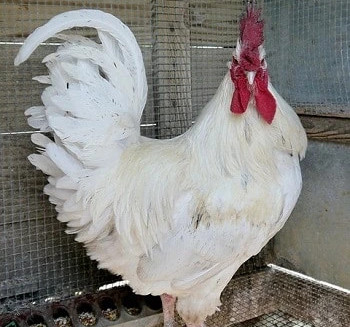When I was a kid you couldn’t really find brown eggs in the grocery store. White egg-laying chicken breeds ruled the roost. Those were the days of white bread, white eggs, sugary drinks galore, and leaded gasoline. A lot has changed since then thank goodness because what we have learned since those bleached-out times is that whole foods are better for you, sugar is the enemy, and lead is poison. So what about the white eggs?
White Eggs Are Good For You!
The nutrient content of eggs is pretty much the same regardless of the color. This is from the U.S. Department of Agriculture March 6, 2023.
“The color of the shell does not affect the nutrient content. There is no nutritional difference between a white and a brown egg. The breed of the hen determines the color of her eggs. Chickens such as the Leghorn, White Rock, and Cornish, lay white eggs. Rhode Island Red, New Hampshire, and Plymouth Rock lay brown eggs.”
In this article, we will take a look at some white egg-laying breeds to better familiarize you with those breeds that can liven up the color of your egg cartons and give you a blank slate for Easter egg coloring fun.
White Leghorns – Queens of The White Egg-Laying Kingdom

When you think of mass-production egg-laying you are probably envisioning thousands of white chickens in cages with their heads poking out from between the wire bars of their confines. Those would be White Leghorns.
White Leghorns are prolific layers laying up to 320 eggs per year. This statistic comes from the internet but I can vouch for it personally. I have had several of these amazing birds and they are extremely reliable when it comes to making eggs.
Characteristics of these chickens include:
- Great egg-laying ability as I have mentioned. Very reliable.
- Flighty – They will happily run from you when you want to corral them into your coop or pen and they will gladly roost outside whether you like it or not.
- Good foragers and have a great forage-to-egg laying ratio.
- Not broody – You will need an incubator if you want to raise these birds.
White leghorns are not the friendliest of chickens. They prefer to remain aloof and just do a wonderful job of laying eggs. As far as pets go, they are fun to watch from a distance. If you want a chicken for a pet, go get yourself a Silkie or two.
They are nervous, flighty, noisy chickens, and not good at all for urban flocks. I guess they would be okay if you don’t like your neighbors.
Just a Little History
I won’t get too deep into this. That’s what Wikipedia is for.
White Leghorns first came to the United States in 1828 and probably landed in Massachusetts. They came from the Tuscany region of Italy. From the U.S. they found their way to Britain in 1870. The birds were known as layers then and they certainly still are today.
Blue Andalusian

The Andalusian or Blue Andalusian is a sleek, hardy, slate-colored chicken that lays a fair amount of medium to large-sized white eggs. It’s not the layer that the White Leghorn is, but it is not far behind, with a rate of 180 on average per year. That is an egg every other day at least.
What sets this chicken apart from most others is that it is a threatened breed. One would do well to take on breeding these lovely-looking chickens in an effort to help bring them back to healthy numbers. You would be in good company with the likes of The Livestock Conservancy if you did so.
The following paragraph on coloration information comes from the conservancy. It is not word-for-word, but the information is accurate.
You get blue-colored birds by crossing black Andalusian with white. When two Blue Andalusian chickens mate, one-quarter of the chicks will have black plumage, half will be blue, and the remaining quarter will be white or splash (white with blue or black splashes). The blue ground color should extend down to the fluff (downy feathers).
To get the best color Blue Andalusian pullets, a dark blue male should be bred to a properly colored hen. To get the best color Blue Andalusian males, both parents should be slightly dark.
Similar to the Leghorns this bird is flighty and hard to catch if you are trying to force them into a confined area against their will. They will roost outside if allowed to.
The Andalusian does not like to be cuddled with, so if you are looking for a pet, don’t depend on this bird.
They are at their best while free-ranging and will cover a large territory. They aren’t fans of confinement and could become aggressive if they don’t get enough space to move about freely. Being great foragers, they have a good production-to-feed ratio.
A Little History
The Blue Andalusian got its name from the place of its origin which is the Andalusia region in southern Spain. It went to England in the mid-1840s and found its way to North America in the mid to late 1850s. It was recognized by the American Poultry Association in 1874.
California White

California White chickens are excellent egg layers. They can produce up to 300 eggs per year, and start laying at around five to six months of age. If that sounds familiar it is because they are actually a cross of White Leghorns and California Greys.
As their name suggests, California White chickens have white feathers. They can, however, have some black spots because there is some Barred Rock genetics in the California Grey lineage. Their legs are yellow and they have a single red comb.
California Whites are slightly larger than White Leghorns and have other characteristics that might be favorable to those who want to raise chickens in an urban area. They are not as noisy as their cousins, or quite as flighty. What they are good at is laying eggs, and foraging.
California White Chickens are not the greatest of pets, but they are relatively calm and do well in more confined spaces.
A Little History
These beauties were developed in the U.S. in the mid-1900s. Originally used as a multipurpose chicken, its broiler use has dwindled as meatier, faster-growing birds have taken its place.
Wrapping it Up
40 years ago you would have been hard-pressed to find a brown, blue, or green egg in the grocery store. The past 20 years have seen a huge increase in the amount of these due to the recognition that all eggs are created equal. There may be a misconception that colored eggs are somehow healthier than white eggs, but this simply is not true, so don’t be afraid to add some of these white egg-laying chickens to your flock.
Thanks for reading. Please leave a comment below if you would like to, or just say hello.
Dave
Chickenmethod.com

